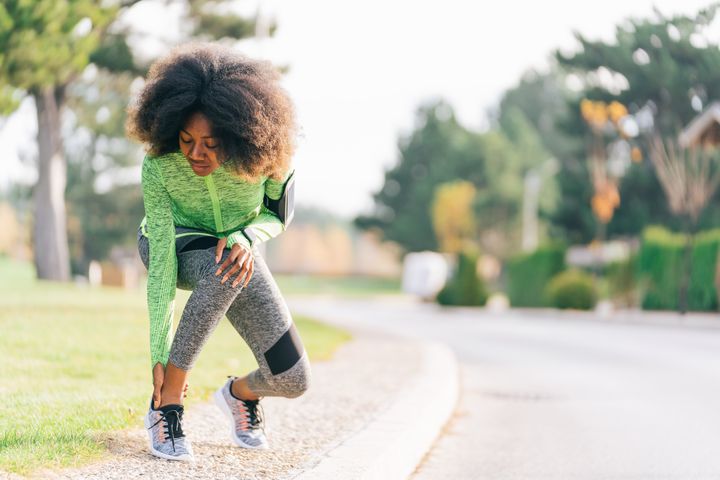Thanksgiving week brings a lot of joyous experiences — turkey, family time, time off from work and, for many people, turkey trots.
Traditionally consisting of a 5K run, the first turkey trot is said to have happened in 1896 in Buffalo, New York, according to The New York Times. Since then, turkey trots have expanded to parks, towns, cities and states throughout the country with likely upwards of 1 million participants. (According to Runner’s World, nearly 800,000 people registered for a turkey trot on the RunSignUp platform last year, which is just one sign-up platform.)
While turkey trots are decidedly fun runs, they can still be tough. In fact, sports medicine experts say there are turkey trot injuries you should know about, along with some tips for avoiding getting hurt. Here are the most common issues:
Runner’s knee.
According to Pamela Geisel, an exercise physiologist, and director of performance and wellness services at the Hospital for Special Surgery in New York City, runner’s knee — an achy or painful knee — is one of the most common turkey trot injuries.
“Because they’re undertaking this activity that is plyometric-based — it is a single leg sport, you’re jumping from one foot to the next and you’re doing it repetitively … And that just adds up over time, particularly if you don’t have the strength or endurance to maintain it,” Geisel said.
She also pointed out that turkey trot participants often join the run with friends or family as an annual tradition and may not be used to consistent running or strength training, which can lead to overuse injuries like this one.
Muscle strains and soreness.
“The issues that we see most commonly, in people who are relatively inexperienced, are a lot of muscle soreness and muscle strains,” said Dr. Timothy Miller, a sports medicine orthopedic surgeon at Ohio State University’s Wexler Medical Center.
Calf strains and Achilles strains can happen, but hamstring strains tend to be most common, Miller added.
“After the race, that’s when people sometimes pay for it when they haven’t been training … even though they may get through the race itself without too much problem, they essentially just finish the race, stop and just kind of get cold. And then the muscles stiffen up from the lack of motion after that,” Miller said.
This can lead to tightness and soreness for two or even three days, he noted. To avoid this, make sure you keep moving after you cross the finish line.
“It’s important to keep those muscles warmed up and limber, and even do what we call a warm down … where you continue a little bit of light activity and stretch well just to minimize that risk of muscle soreness or discomfort the following day,” Miller said.
Dr. Colby Genrich, a sports medicine specialist at Texas Tech Physicians of El Paso, added that strains can also occur if someone doesn’t warm up before a run.
Sprains.
According to Genrich, sprains are another issue that commonly comes out of short-distance runs like turkey trots.
“A sprained ankle, for instance, [is when] one of the ligaments ― the connections between two bones ― gets a little bit overstressed,” Genrich said. “And that leads to swelling and pain in the joint.”
This can happen in the knees, ankles and hips, he said.
Injuries from trips and falls.
Chalk it up to uneven roads, potholes or crowds of people, it’s pretty common to see injuries from falls during a turkey trot, according to Genrich.
“A lot of these participants are running on uneven surfaces — roads that haven’t necessarily been maintained perfectly — so there are potholes, uneven surfaces, rough surfaces, or changes in surfaces between maybe asphalt and then more smooth concrete,” Genrich said. “And that leads to some trips and falls which necessitate some first aid.”
These trips and falls could lead to several acute injuries.
“[If] you can’t really see the ground around you, it’s fairly easy to step a little bit awkwardly and roll your ankle, or have issues take place,” Genrich added.
Scraped and bruised knees or elbows could also accompany a fall.
valentinrussanov via Getty Images
To protect yourself from injury, be sure to do a proper warmup and cooldown.
It can be chilly on Thanksgiving morning, and you don’t want to dive into your run with cold muscles.
To prevent issues during the race, Miller said you should warm up 30 to 45 minutes before the race start time — this could mean walking, jogging, doing high knees or leg swings.
Whatever you choose to do, make sure you’re doing an active warmup — which gets your heart rate up and your muscles warm — not a static warmup, which has lots of standing and stretching, Genrich said.
“You want to be a little bit warmed up and sweaty by the time the race starts just to make sure that your body is really ready to go [and] you don’t have any unexpected issues take place with the muscles and the tendons when you first get started,” Miller noted.
As mentioned, it’s also crucial that you don’t stop moving as soon as you cross the finish line. Athletes can run into problems, like cramping and soreness, when they suddenly stop a tough workout, Genrich explained. “When you finish the race, continue to walk or lightly jog and … decrease that heart rate and keep the muscles firing so that the muscles stay warm, and then gradually come to a stop in your activity.”
Be intentional about your race outfit.
New sneakers can also be a culprit for race-day injuries. To avoid this, Genrich said you should wear shoes that are broken in and supportive.
Beyond this, you should be mindful of what you wear, too.
“People who don’t typically run aren’t really familiar that your body is going to warm up throughout the run … you do want to dress like it’s about 10 to 15 degrees warmer than it really is,” Geisel stated.
Oftentimes, turkey trotters overdress for their run and end up uncomfortable a few miles in, Geisel said.
“They end up very, very overheated, or very warm and uncomfortable, and then that takes additional energy for your body to try to regulate its temperature,” Geisel said.
It’s also important to properly fuel yourself after your run.
“You certainly want to hydrate as quickly as you can afterward and get a nice little snack within about a half hour or so of the race,” Miller said, noting that it’s important to refuel your body and muscles afterward, ideally with a high-protein and carb-forward food.
And drinking water or a sports drink is something that many people forget during turkey trots thanks to the cold weather and shorter distance, Miller said. “You just want to make sure you replenish that after the race is completed.”
Additionally, set realistic exercise expectations.
Injury tends to occur when your body isn’t prepared for a specific workout. If you are signing up for a turkey trot as more of a fun run, and haven’t trained for the full race, don’t pressure yourself to keep up with those around you, said Geisel.
“Let’s say it’s a five-mile turkey trot, if you are someone who has not been running five miles, it’s really important that we’re not going out there and trying to keep up with our cousin Joe, who runs five miles every other day,” Geisel said.
Instead, she recommends running three minutes and walking two until you get to the end of the run. “Having those work-rest intervals is going to make it a little bit more tolerable, and I promise that you’re still going to feel great at the end of five miles.”
Geisel also noted that it’s important to listen to your body throughout the turkey trot, which is decidedly a distracting environment with holiday excitement and runners of all ages.
No one wants to get injured before the big Thanksgiving dinner anyway.


